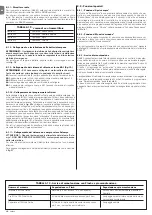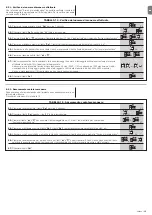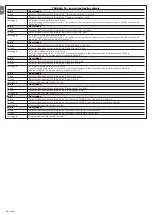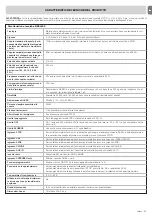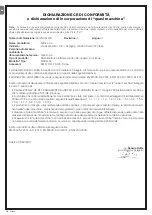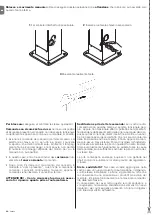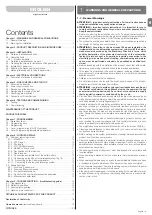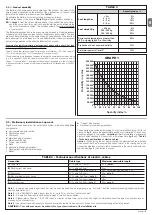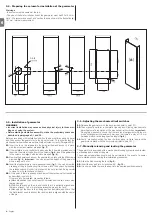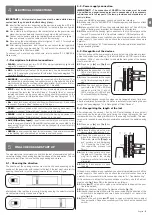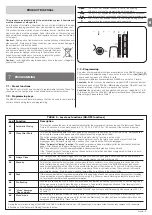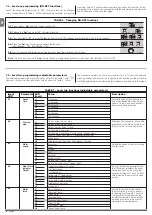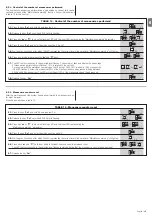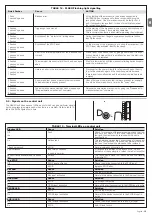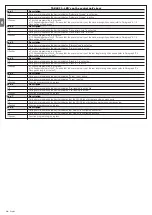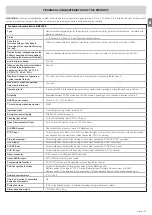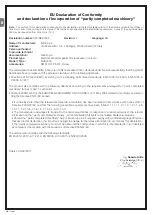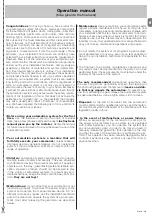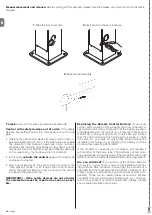
EN
English –
5
ELECTRICAL CONNECTIONS
4
IMPORTANT!
– All electrical connections must be made while discon-
nected from the grid and the buffer battery (if any).
01.
Insert all the cables for connecting up the devices, leaving them 20 to 30
cm longer than necessary. Refer to table 5 for the cable type and figure 2
for connections.
02.
Use a clamp to hold together all the cables that enter the gearmotor, and
place the clamp underneath the hole through which the cables enter.
03.
Connect up the power cable to the terminal provided, as shown in figure 11,
then use a clamp to lock the cable onto the first cable ring.
04.
Connect up the other cables as shown in figures 12 and 13. Terminals are
removable for greater convenience.
05.
After making connections, lock the cables you have collected together in
place using the rings provided (fig. 12), and anchor the excess part of the
antenna cable to the other cables.
To connect up 2 motors on opposite doors, refer to section “8.1.5 NAKED in
Slave mode”.
.1 - Description of electrical connections
• FLASH
= output for one or two “LUCYB” or similar type flashing lights with
single 12V maximum 21W bulb.
•
OGI
= Open Gate Light” output. An indication lamp can be connected (24V
max. 4W). It can also be programmed for other functions; see paragraph “7.4
Level two functions”.
•
BLUEBUS
= compatible devices can be connected up to this terminal. They
are connected in parallel using two conductors only, through which both the
electricity supply and the communication signals travel. For more useful infor-
mation about BlueBUS see also Paragraph “8.1.1 BlueBUS”.
•
STOP
= input for the devices which block or eventually stop the manoeuvre
in progress. Contacts like “Normally Closed”, “Normally Open” or constant
resistance devices can be connected up using special procedures on the
input. For more useful information about STOP see also Paragraph “8.1.2
STOP Input”.
•
Sbs
= input for devices which control Step-by-Step movement. It is possible
to connect “Normally Open” devices up to this input.
•
OPEN
= input for devices which control only the opening movement. It is
possible to connect “Normally Open” devices up to this input.
•
CLOSE
= input for devices which control only the closing movement. It is
possible to connect “Normally Open” devices up to this input.
•
AUX_IN (Auxiliary Input)
= input for devices that block or stop the mano-
euvre in progress; Normally Closed (NC) contacts can be connected to this
input; using Oview, the input function can be changed; the input is factory
configured to ALT.
•
AERIAL
= aerial connection input for radio receiver; the aerial is incorporated
in the flashing light; alternatively, an external aerial can be used.
The manufacturers recommend you position the leaf at approximately half tra-
vel before starting the checking and start up phase of the automation. This will
ensure the leaf is free to move both during opening and closure.
5.1 - Choosing the direction
The direction of the opening manoeuvre must be chosen depending on the
position of the gearmotor with respect to the leaf. If the leaf must move left for
opening, the selector must be moved towards left as shown in Figure,
alternatively, if the leaf has to move right during opening, the selector must be
moved towards the right as shown in Figure.
FINAL CHECKS AND START UP
5
5.2 - Power supply connection
IMPORTANT!
– The connection of NAKED to the mains must be made
by qualified and experienced personnel in possession of the necessary
requisites and in full respect of the laws, provisions and standards cur-
rently in force.
As soon as NAKED is energized, you should check the following:
01.
Make sure that the “BLUEBUS” LED flashes regularly, with about one flash
per second.
02.
Make sure that the LED’s on the photocells flash (both on TX and RX); the
type of flashing is not important as it depends on other factors.
03.
Make sure that the flashing light connected to the FLASH output and the
lamp LED connected to the “Open Gate Indicator” (OGI) output are off.
If the above conditions are not satisfied, you should immediately switch off the
power supply to the control unit and check the electrical connections more
carefully.
Please refer to Chapter “9.1 Troubleshooting” for further information about find
-
ing and analysing failures.
5.3 - Recognition of the devices
After connecting up the power supply, the control unit must be made to reco-
gnise the devices connected up to the BLUEBUS and STOP inputs. Before
this phase, LEDs L1 and L2 will flash to indicate that recognition of the devices
must be carried out.
01.
Press keys
[
s
]
and
[Set]
and
hold them down.
02.
Release the keys when L1 and L2
LED’s start flashing very quickly
(after approx. 3 s).
03.
Wait a few seconds for the control
unit to finish recognizing the devi-
ces.
04.
When the recognition stage is
completed the STOP LED must
remain on while the L1 and L2
LED’s must go off (LEDs L3 and
L4 will eventually start flashing).
The connected devices recognition stage can be repeated at any time, even
after the installation (for example, if a device is installed); for performing the new
recognition see paragraph “8.1.6 Recognition of Other Devices”.
5.4 - Recognizing the length of the leaf
After recognizing the devices, L3 and L4 LED’s start flashing; the control unit
must recognize the length of the gate. During this stage, the length of the leaf
is measured from the closing limit switch to the opening limit switch. This mea-
surement is required to calculate the deceleration points and the partial opening
point.
01.
Press keys
[
s
]
and
[Set]
and
hold them down
02.
Release the keys when the ma n-
oeuvre starts (after approx. 3 s)
03.
Check the manoeuvre in pro-
gress is an opening manoeuvre.
Otherwise, press the
[Stop]
key
and ca refully check Paragraph
“5.1 Choosing the Direction”,
then re peat the process from
Point 1.
04.
Wait for the control unit to open
the gate until it reaches the ope-
ning limit switch; the closing
ma noeuvre will start immediately
af ter wards.
05.
Wait for the control unit to close
the gate.
If the above conditions are not satisfied, you should immediately switch off the
power supply to the control unit and check the electrical connections more
carefully. For more useful information see also chapter “9.1 Troubleshooting”.
If it is necessary to adjust limit switch positions more finely, use the 2 adjust-
ment knobs (
fig. 14
and
15
) in the gearmotor, as follows:
01.
Press
s
or
t
on the unit to open or close the leaf on the basis of the posi-
tion to be defined.
02.
Remove the cover locking the 2 adjustment knobs (
fig. 14
).
03.
Identify the adjustment knob with the arrow indicating the direction of the
limit switch to be adjusted and turn it half a turn (about 3 cm travel of the
gate)
fig. 15
.
04.
Next, on the unit, press
s
or
t
again to open or close the door to adjust
the new position. Repeat as necessary until the door has the desired limit
switch.
Summary of Contents for Naked Sliding NKSL400
Page 2: ......
Page 43: ...I 405 mm 131 mm 135 mm 1 3 4 5 b d c c h l b f m g i n e a E C F D C F A B 2...
Page 44: ...II b a b a c 5 mm 6 7 10 11 8 9...
Page 46: ...IV 14 15...
Page 48: ...VI 19 20 a b c d e...
Page 49: ...VII 21 22...
Page 50: ......
Page 51: ......


